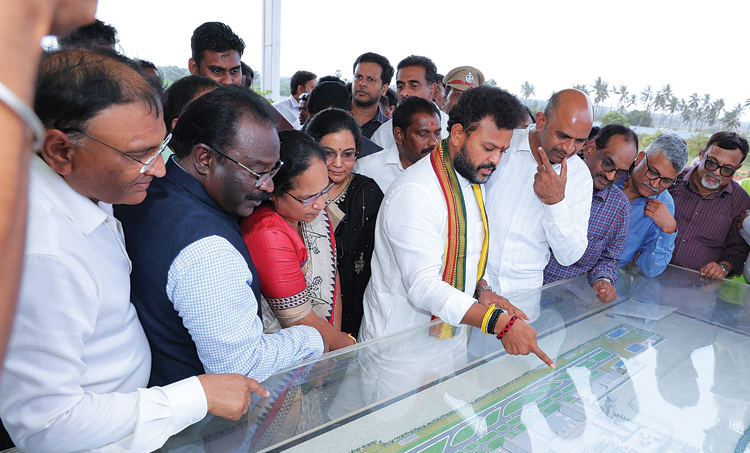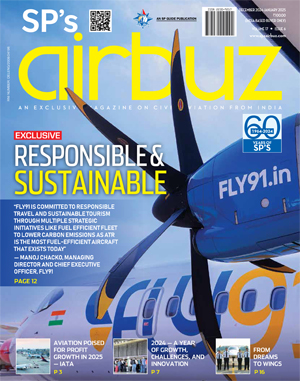New Leadership to Navigate Growth
Will the new Civil Aviation Minister meet the challenges and demands of India’s aviation boom?

The aviation sector all over the globe has shifted gears and bloomed over the last one year. Revenge travel, new aircraft soaring aircraft orders, business travel, family vacations, increasing investments from leading OEMs and MROs setting up R&D centres, hangars, and training facilities in India, the last couple of years have seen it all. At this juncture, India witnessed the return of Modi 3.0 governance with the reins of booming Indian aviation sector switching to one of the youngest ministers in Modi cabinet – 36-year-old, Kinjarapu Rammohan Naidu, India’s new Civil Aviation Minister.
INDUSTRY SPEAKS TO MOCA
“India’s new Civil Aviation Minister enters the ministry at an opportune time,” says Prakash Babu Devara, Director of product marketing, Cognitus. “The industry outlook, while quite positive,” also faces challenges, Devara adds. To create a win-win situation, the minister can play a crucial role in enabling the industry to navigate these challenges and sustain its growth momentum.
Speaking of Naidu, although he has strong political background and knows his ground well, experts believe he has a host of challenges as the new minister of civil aviation. In fact, one of his very first quotes after officially handling the charge – “Will strive to reduce air fare and make flying more affordable for common man,” was cautiously looked upon by domestic airlines who are already operating on wafer-thin margins.
India has one of the largest aircraft orders in the world – 1,150 aircraft by 2035 to be precise, but is the country’s foundation firm enough to handle the aircraft and the rising passenger demand. Developing a sound aviation eco-system is one of the biggest challenges facing our new minister. Besides another key problem is the demand from Middle Eastern carriers for more bilateral flying rights. Jaideep Mirchandani, Chairman of SkyOne advocates for the bilateral rights. He says “Considering this boom, we hope the new minister will address the ongoing demand from the UAE and Qatar for more bilateral flying rights. We seek a balanced approach that promotes fair competition and growth for all stakeholders and opens new avenues for growth.”
AIRPORT DEVELOPMENT
Another major issue is developing more Indian hubs on the lines of Dubai and here, funding for the expansion plan at private airports remains a major cause of concern. Mirchandani hopes that the ministry prioritises the development of Indian hubs to rival those in Dubai and Doha. “This includes securing funding for airport expansions and solving the resource shortages, such as pilots, engineers, and air traffic controllers, to support rapid growth,” he adds.
“The Minister needs to focus his attention on facilitating the growth of civil aviation to realise the ambitious plans of increasing the number of airports and introducing hundreds of new air routes,” says Subir Hazra, Chief Commercial and Strategy Officer at GMR Services, GMR Group. “MoCA should design policies and take initiatives to develop the major Indian Airports as the global transit hubs to boost international traffic, rival the world’s premier aviation hubs, and increase the operational efficiency,” Hazra echoes Mirchandani’s thoughts.
He further lists down the following pointers for Minister’s eyes:
- Full support should be extended to Airport operators to modernise and extend non-aeronautical services at the airport.
- Airport land development should also be given top priority to compete with world-class standards promising benefits not only to the aviation industry but also to the nation’s overall economic development.
Additionally, the government’s plan to lease out 13 airports to private players is on hold since past four years. Mirchandani also hopes that ministry speeds up the plan to lease out 13 airports to private players. “We hope the revival will be quick, as it is crucial for modernising our aviation infrastructure and enhancing operational efficiency,” he adds.
Arvind Chandrasekhar of Lufthansa Consulting sums it up. “Reinvigorate asset development and capacity expansion, including reinitiating stalled airport privatisation are the key areas that the new minister needs to focus on.”
SKILLING
Shortage of skilled talent to take up the rising aviation sectoral special posts is a universal key concern, but India will soon face a major brunt of it, as newer and more advanced next-Gen aircraft start flying in Indian skies. India significantly lacks the skilled manpower required to operate aircraft, maintain aircraft, engines, and components, and manage the supply chain. Therefore, Hazra emphasises on strong focus on establishment of world-class training institutions to create a future-ready workforce.
India’s new Civil Aviation Minister takes charge at an opportune time, with the industry outlook quite positive but facing challenges that need careful navigation to sustain its growth momentum
“Airlines and MROs can only make a limited impact,” Devara adds. He urges the government to take the initiative to make aviation a more attractive career option for students and young people. “Similar to the IT and software industry boom since the 1990s, aviation needs a similar push from the ground level,” Devara adds.
He goes on to give various options to the ministry like:
- incorporating more aviation-related courses into the curriculum,
- encouraging the establishment of more aviation academies or centres,
- and creating more career opportunities.
Achieving this requires coordination with multiple stakeholders across the industry, which the ministry can facilitate. Chandrasekhar also urges the minister to enhance crew capacity for the industry through supporting the establishment/expansion of flight training academies and stringently monitoring quality and safety.
DIGITAL TRANSFORMATION
The aviation sector is ripe for digital transformation, and experts expect the new minister to support the integration of cutting-edge technologies like implementing advanced air traffic management technologies to improve the efficiency and safety of air operations, reducing delays and fuel consumption.
Lynn Frederick Dsouza, National President - Aviation Council, WICCI and Founder & Director - ESPIRIDI feels that the minister should focus his attention to facilitate investments in R&D to drive innovation in areas such as aircraft technology, sustainable fuels, and air traffic management systems. Besides adequate support should be given to encouraging startups and entrepreneurs by creating a supportive ecosystem, fostering innovation and the development of new technologies and services.
Chandrasekhar feels that simpler process and acceleration of technology adoption is the fastest route to progress. “The recent FTI-TTP is a positive step. There are many steps to be taken, e.g. expanding DigiYatra across airports and to international flights, introducing automated immigration, digitising or eliminating entry forms for foreigners, pushing for investment in better security infrastructure and more.” Chandrasekhar adds.
MRO DEVELOPMENT
Development of MRO-sector is a major cause of concern as the sector has been much neglected over the years. Aircraft – new or old need maintenance and the sheer lack of well-developed capabilities in India has led airlines lose a major chuck of their revenue oversees to repair the aircraft. The minister needs to look into development of third-party MROs, giving them a boost and much-needed respite from the red-tape rules and taxes.
The disinvestment of AI Engineering Services (AIESL), AI Airport Services, and regional airline Alliance Air is still an unsolved mystery post Air India privatisation. Although Air India along with Lufthansa Technic has shown interest in buying AIESL, nothing has been confirmed as per sources.
STRENGTHENING CYBERSECURITY FRAMEWORKS
With the increasing digitisation of the aviation sector, cybersecurity has become paramount. Experts expect the new minister to prioritise the development and implementation of robust cybersecurity policies and frameworks that protect critical aviation infrastructure from cyber threats.
India has one of the largest aircraft orders in the world – 1,150 aircraft by 2035, but developing a sound aviation ecosystem to handle the rising passenger demand is a significant challenge
Dsouza further draws attention to incident response and recovery plans like developing comprehensive incident response strategies and recovery plans to quickly and effectively mitigate the impact of any cybersecurity incidents, ensuring minimal disruption to services. She feels that the ministry should focus on state-of-the-art threat detection systems and continuous monitoring of networks and systems to identify and address vulnerabilities proactively.
CARGO DEMANDS
Civil Aviation’s cousin, Cargo sector also needs some attention from MoCA. As Indian airports prepare for a 10-million-tonne air cargo handling by 2030, the Minister of Civil Aviation should spearhead initiatives to bolster infrastructure. Hazra further elaborates his demands for cargo sector as follows:
- Expansion & modernisation of existing cargo terminals
- Establishment of new cargo terminals (including integrated, multimodal, and dedicated facilities)
- Foster collaboration between the government, industry associations, and key stakeholders
- Streamlining regulatory procedures
- Setting up world-class cargo hubs within the country and enhancing air connectivity with major global hubs
- Improving intermodal connectivity
- Simplifying customs clearance processes
- Promoting automation & digitalisation.
THE TWO R’S – REGIONAL CONNECTIVITY & REGULATORY POLICIES
Effective implementation of policies and regulations that ensure fair competition, passenger safety, and environmental sustainability in the aviation sector is yet another major lookout for the new minister. Speaking of UDAN (Ude Desh ka Aam Nagrik) scheme, Hazra asserts that the minister should also look at the launch and success of such initiatives that promote air travel in underserved and remote areas will accelerate the realisation of goals for the Indian Aviation industry.
Devara feels that while the Modi Government’s UDAN scheme had good intentions, it hasn’t taken off as planned. “A key reason is the lack of infrastructure, including a need for more airports, improved airport facilities, and upgraded Air Traffic management units. This requires collaboration with state governments for land pooling, capital funding, and obtaining necessary regulatory clearances. The aviation minister can significantly support the industry in this area,” Devara asserts. Chandrasekhar meanwhile advocates for simplification of taxation on aircraft turbine fuel (ATF) along with ensuring full staffing of the DGCA positions and enforcement capability.
He also feels that the ministry should pursue policy design and inter-governmental negotiations to make possible a full aircraft production line in India from one of the major international OEM. “The government should allow the aviation industry to operate in a deregulated manner on commercial aspects,” Chandrasekhar adds.
SUSTAINABILITY
Indian The government has already set a roadmap for the adoption of SAF for one per cent blending of SAF for domestic flights by 2027 and two per cent for international flights by 2028. To achieve these targets, the minister needs to pay special attention at promoting sustainable initiatives.
Elaborating on various sustainable initiative Dsouza throws light on Green Airport Initiatives. She says “Implementing policies to support the development of green airports that use renewable energy, reduce waste, and have sustainable infrastructure.” She further goes on to speak on Carbon Offset Programmes and urges the minister to establish and promote carbon offset programs that allow airlines and passengers to compensate for their carbon emissions, contributing to broader environmental sustainability efforts.
“To achieve this and accelerate the adoption of sustainability practices in the Aviation Industry, India-specific environmental sustainability frameworks in the Aviation industry should be conceptualised and implemented that cater to the specific requirements of our fast-growing economy, and remove our dependence on global frameworks which are ill-suited for our growth,” Hazra concludes.
FINANCIAL PERFORMANCE OF AVIATION INDUSTRY
While financial performance and strong growth is not the sole responsibility of the Ministry, regulations and initiatives to ensure a good financial health of entities in the Aviation sector should also be one of the top concerns. Dsouza feels that the minister needs to implement mechanisms to support the financial stability of airlines and other aviation stakeholders during crises. “This could involve emergency funds or fiscal incentives,” Dsouza adds.
With the increasing pace of privatisation of airports under the PPP model, typically with concession tenure of 30+ years Hazra argues that loan assistance from major banking institutions with repayment period matching the concession tenure and a justified interest rate should be prioritised. Apart from the above, as only a few major airlines control the Indian aviation industry, needful financial and regulatory assistance should be extended to ensure continuity of operations.
Looking carefully at all of the above, one cannot leave out a key aspect of commercial aviation- The Passenger. The ‘one’ who can make or mar the reputation of an airline or an airport. In today’s world passenger experience and ease of travel holds significant importance as passenger seek more comfort, luxury and safety while travelling. Devara draws attention to a key challenge for passengers – ‘overcrowded airports.’ “With the surge in air travel demand, major airports across the country are operating beyond capacity. Long queues at security checkpoints, congested terminals, and delayed flights are commonplace, leading to passenger dissatisfaction and hampering operational efficiency. The ministry needs to prioritise this issue and take steps to mitigate these challenges,” Devara says.
All-in-all Mirchandani hopes to collaborate under Naidu’s leadership to witness the new chapter in the Indian aviation sector. “With the passenger traffic increasing, new airports and major airlines expanding their operations and upgrading their fleets, the future looks bright,” Mirchandani concludes.





